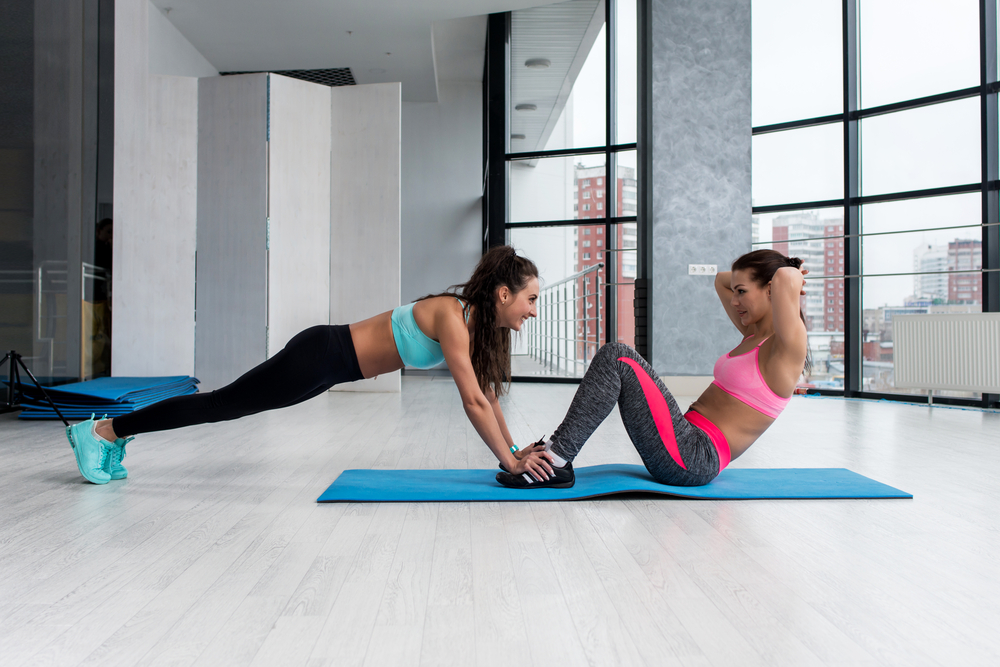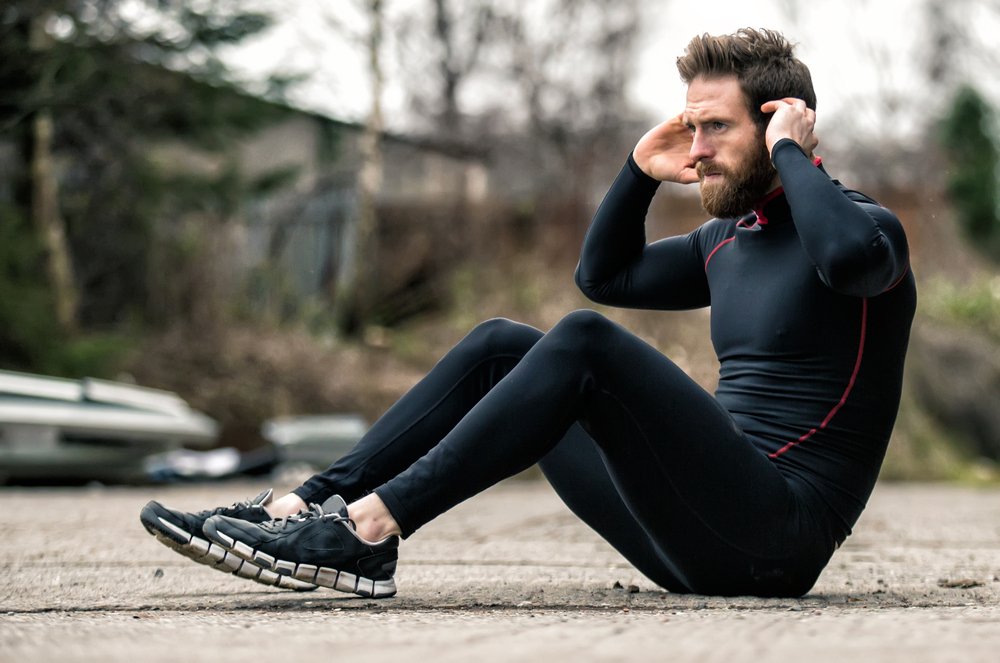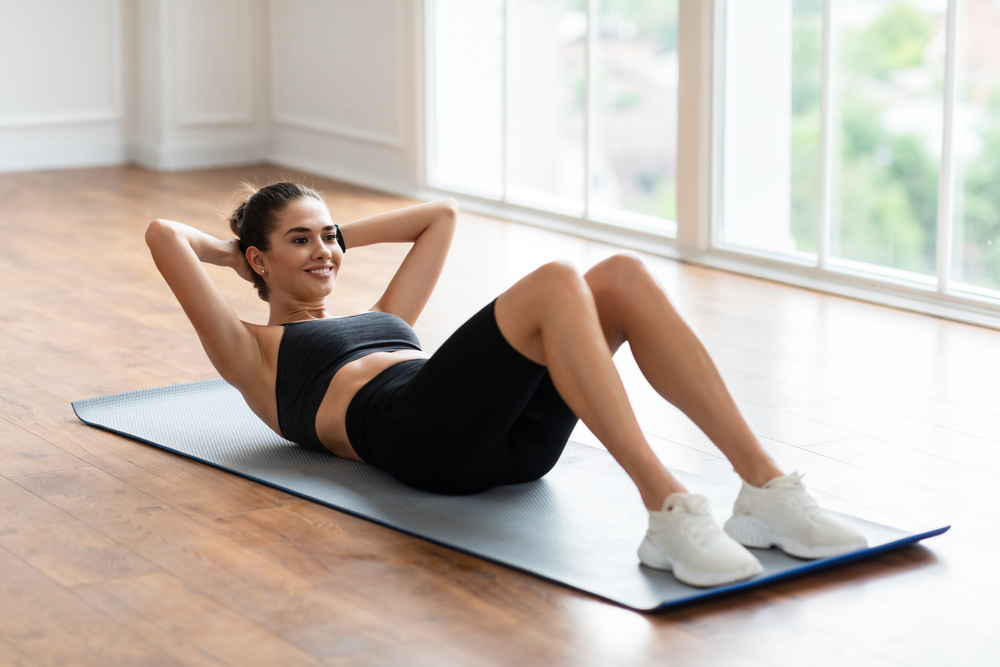Sit-Ups are a well-known exercise, often connected with obtaining a flat stomach. The full exercise consists of laying on your back with your knees bent while moving your neck and head forward to meet your knees. While sit-ups are a good workout to include for this goal, it is often a combination of factors that result in losing weight.
On average, a person will burn a maximum of 10 calories doing 100 sit-ups. Sit-ups are a resistance workout, not an aerobic one. This means they help tone your muscles but will not lead to weight loss as a standalone exercise. Rather, add these to a cardio, HIIT, or strength training, along with a balanced diet.
This article will explore more information about sit-ups, their benefits, and their disadvantages. Let’s get going!
Contents
How Many Sit-Ups Should I Do a Day to Lose Weight?
As you may know, losing weight is an equation that is different for everyone. We want the number of calories burned to be higher than the number of calories consumed. Age, gender, and body type also play a part in losing weight as well.
The best way to lose weight doing sit-ups, you should combine this exercise with cardio or strength training, and a balanced diet.
For each pound of weight loss, 3,500 calories need to be burned. Below is a chart that shows the calories burned after completing a session of sit-ups for 30 minutes. We have included the results from individuals of different weights, as they burn calories differently.
| Weight of Person Doing Sit-Ups (For 30 min.) | Calories Burned |
|---|---|
| 125 | 135 |
| 155 | 167 |
| 185 | 200 |
As you can see, none of these numbers are close to that goal of 3,500 we need to shed a pound. Additionally, doing only sit-ups for 30 minutes is quite difficult for most. This is not to say that you can’t lose weight doing sit-ups, it just might not be the most effective sole workout done to meet your goals.
Will I Lose Weight Doing 100 Sit-Ups a Day?
The average person can do about 20-30 sit-ups per minute. An athletic individual may be able to complete anywhere between 50-60 sit-ups in that time.
This means that 100 sit-ups will take you anywhere between 2 and 4 minutes. Using our chart above, you can see that an estimated 150 calories are burned doing 30 minutes of sit-ups.
If we break this down, the average person will burn a maximum of about 10 calories doing 100 sit-ups. Doing only 100 sit-ups per day will not show phenomenal results in weight loss. It is best to pair this activity with a routine of strength training, resistance, or even cardio.
How Many Sit-Ups a Day to Get a Flat Stomach in 2 Weeks?
A flat stomach is directly related to your diet. If you want a 6-pack, you won’t be able to see if it is hiding under belly fat.
The best way to see a flat stomach is a combination of cardio, core training, and most importantly, diet. Once you have lost weight in your stomach region, you will be able to start seeing your abs. Then you can train your core to gain those 6-pack muscles!
We will go into more detail regarding tips for weight loss later in this article. Stick around for the best and most effective ways to reach your goal!
How Many Sit-Ups to Burn 1,000 Calories?
Burning 1,000 calories is going to be a challenge when you are doing any activity. But, burning this many calories can lead to serious weight loss – up to 2 pounds per week! If we use the chart above, you can see that about 150 calories are burned in 30 minutes of sit-ups.
Using this math, it would take about 3.5 hours of sit-ups to burn 1,000 calories. We can think of many different activities we would rather do for 3.5 hours besides sit-ups!
How Many Sit-Ups a Day for Beginners?
Sit-ups are a relatively easy exercise, as long as you do not have serious back or neck issues. You should be able to complete a set of sit-ups without excessive strain or risk of injury. Experts recommend doing 3 sets of 8-12 reps of sit-ups per day. This can be done every day, even for a beginner.
As your muscles grow stronger, this routine may become too easy. You can build up your sets to be 15, 20, or as many reps as you can!
How to Properly Do Sit-Ups
Having the proper form during any exercise will give you the best results and prevent injury.
Here’s a step-by-step breakdown of how to do a proper sit-up:
- Lie on your back. (This can be on the floor, a mat, or a bench.)
- Bend your knees and bring your feet directly under to secure yourself. (Pro-Tip: Use a brace, bar, or weight to hold your feet down. Or, if you don’t have that equipment, you can ask a partner to hold your feet while you do sit-ups.)
- Put your hands behind or beside your neck.
- Bend forward so that your elbows touch your knees, you’ll feel this in your core.
- Lower your body back to the laying position.
- Repeat!
Which Muscles Do Sit-Ups Work?
We mentioned that doing sit-ups is a strength training workout. But what muscles are used exactly?
Below is a list of which muscles are used during a sit-up and how they are used.
1. Rectus Abdominis
- This is a long row of muscles in the middle of your stomach.
- Working these muscles will build that desirable 6-pack.
- During a sit-up, this muscle is strained to bring your body forward towards your knees.
2. Transverse Abdominis
- The transverse abdominals are the deepest abdomen muscles, laying underneath the rectus abdominis.
- Working the transverse abdominis is critical if you want a strong core.
- Strengthening this muscle also reduces back pain and makes day-to-day activities easier.
3. Oblique Abdominal Muscles
- The oblique abdominal muscles, or “obliques” are on the sides of your trunk.
- Training the obliques has many benefits. These can include better posture, improved balance, and less lower back pain.
4. Hip Flexors
- As you bring your upper body up, your hip flexors will be engaged helping you do so.
- This is the muscle that runs from the lower vertebrae in the back down your thigh.
5. Chest
- Although not a killer chest workout, sit-ups still engage the chest muscles a little.
- Your chest is squeezing as you bring yourself up. This results in strengthening that muscle region.
Benefits of Sit-Ups
Incorporating sit-ups into your workout routine can have positive results. Take a look at these benefits below:
Core Strength
Core strength is one of the main reasons for doing sit-ups. A strong core powers many of your day-to-day movements as well as other exercises.
Improved Stability
One of the benefits of a strong core is improved stability or balance. Your core works together with your pelvis, lower back, and hip muscles to keep your body standing. As you grow older, a better balance will prevent falls which could lead to injury.
Better Posture
Have you ever looked in the mirror while you a sitting and noticed terrible posture? Sitting or standing hunched over can have terrible effects on your breathing, muscle tension, and energy.
Doing sit-ups strengthens your core so that your spine and shoulders can stay aligned.
Reduce Risk of Injuries
Improved stability and good posture all lead to less risk of injury to our lower back or pelvic region. Core strength is the reason behind all of this.
For example, say you are doing an exercise and lose balance, resulting in a fall that injures your back, legs, etc. A firm core can prevent this nasty incident.
Downsides of Sit-Ups
While sit-ups are a classic workout, they do not come without disadvantages. Here are a few reasons why you may want to do sit-ups sparingly:
Not The Most Effective
If your goal is to lose weight and have an intense workout session, sit-ups alone are not going to do it for you. In order to lose weight, you will need to engage in cardio and other strength training activities.
Can Lead to Back Injury If Not Done Properly
If your back is too hunched while doing a sit-up, this could cause injury over time. Repeatedly curling your back is not good for it in the long run.
Additionally, some people will pull on their necks as they come forward in a sit-up, this could result in neck strain if done too intensely. For these reasons, proper form is important when practicing sit-ups.
Sit-ups vs. Crunches
Some may think that sit-ups and crunches are the same activity. While they both target the abdomen, they are in fact different workouts.
The form of a sit-up and a crunch is very similar. Start laying on your back and use your abdomen to bring your body forward.
| Excerise | Sit-ups | Crunches |
|---|---|---|
| Form | Brings your full upper body up, leaving you in a seated position | Bringing your head and shoulders forward |
| Muscles Worked | Abdomen Hip flexors Chest | Abdomen |
What Exercise Can I Add to Sit-ups?
Sit-ups are not a great workout to complete alone. They are better paired with other activities. With that in mind, you may be wondering what the best activities to incorporate them with for the best results.
Sit-ups can be added to any workout. Do a few sets following cardio or HIIT session after your abdomen has warmed up. You can add sit-ups to a core strengthening routine with planks, crunches, and hollow holds.
Tips for Weight Loss
Doing sit-ups alone will not lead to weight loss. Previously stated, this is a combination of diet, cardiovascular exercise, and strength training resulting in higher calories burned than consumed.
Below are the top tips to lose weight:
- Keep a food and weight journal to track progress
- Measure food portions and numbers associated with protein, fat, and carbohydrates
- Engage in regular physical activity or exercise
- Join a social group for support and motivation
- Plan ahead (meal prep!)
- Get a good night’s rest each night
- Stay hydrated with water (cut out sodas, juices, and other high-calorie liquids)
- Stay positive! Results take weeks and months, not hours and days



